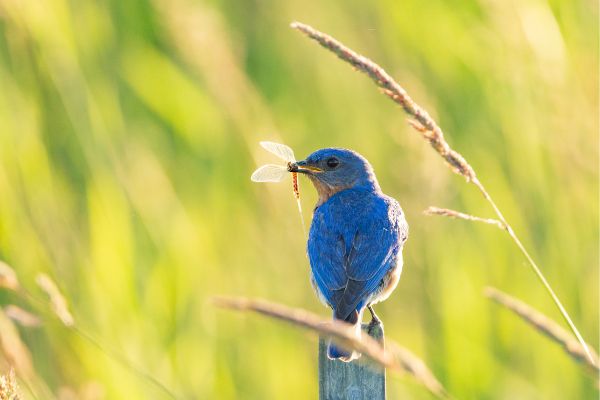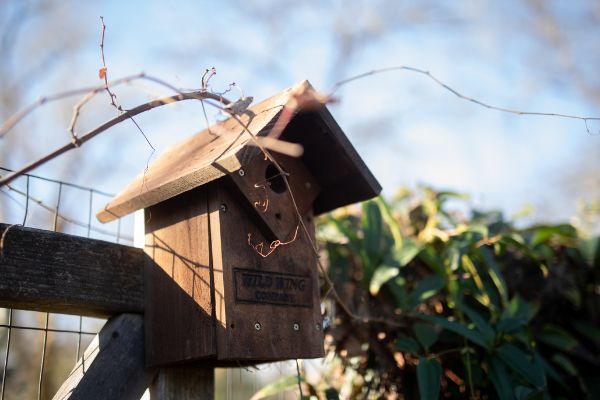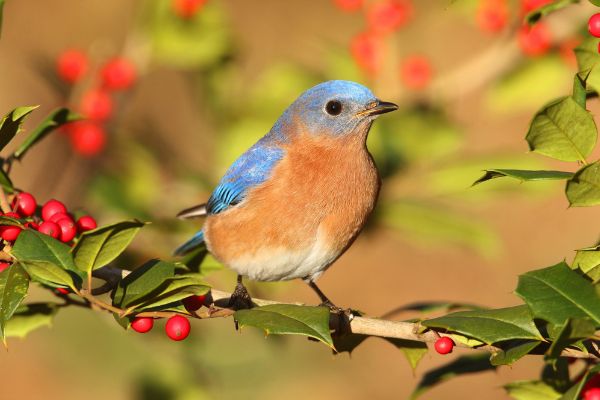Farming with nature: The benefits of bluebirds on a vineyard
Part of our regenerative wine farming practices includes symbiotic relationships with wildlife, including our local bluebirds.
Some wineries discourage birds in the vineyard, placing imposing reflective materials, liquid deterrents, and even nets and spikes to deter them from eating the fruit. We’ve found a happy medium. We encourage bluebirds to make our vineyards their home, and not just because bird life is indicative of a healthy ecosystem.
The natural alternative to pesticides
Bluebirds are natural pest controllers. Their mere presence discourages gophers, voles, and other vine-damaging critters from getting comfortable in our vineyards. But they also eat vine-damaging bugs, making them nature’s version of pesticide. A great example of how we work in balance with nature, eliminating the need to pollute the environment with chemicals and toxins.

Providing safety for bluebirds to thrive
While our healthy, nutritious soils are reason enough for bluebirds to want to settle in as resident caretakers, every spring we make vineyard life extra enticing by placing 64 bird boxes on our Lyon Vineyard and 34 bird boxes on our Cisne Vineyard.
Perfect for nesting, these welcoming homes are occupied almost immediately when placed in early spring and enjoyed until around mid-June, when the hatchlings are ready to take flight.
During nesting, we monitor the bird boxes on a weekly basis to ensure a healthy and safe environment for our helpful birds. Once our feathered friends depart, we remove the abandoned nests and clean the boxes to ready them for next year’s nesting season.
Leaving it wild for birds of all species
Around the time the bluebirds make their annual departure, our grapes begin to get plump and juicy. As you can imagine, this is an irresistible invitation to other birds, especially those who love grapes, so during this brief time of year, we add protective netting and reflective tape in the vineyards.
But even then our grounds remain popular with hawks, falcons, kestrels, and barn owls because we actively welcome them by leaving up to 15 percent of our farm wild, as a natural habitat for bird life.

All of our bird-friendly efforts are another example of us working in harmony with nature to produce outstanding wines that can truly express their environment. All these practices are fundamental to our commitment as regenerative farmers, and our mission to improve the land and give back more than it gives us.
Read more about life on a regenerative wine farm
Learn about our farming practices
Discover how we use sheep for sustainability
How to attract bluebirds around your home
Bluebirds can be hard workers at your home too. Along with a beautiful song and pretty plumage, they can be your natural pest controllers, as they are in our vineyard. Their diet includes the types of insects most people would prefer not to have in the house or around the yard, such as grasshoppers, crickets, ants, spiders, moths, termites, and mosquitoes. So, why not attract bluebirds rather than use chemicals around your home and family to eradicate these pesky insects? We’ve been attracting bluebirds successfully to our vineyard for a few years now and have learned it doesn’t take too much effort. Provide the simple necessities of food, water, shelter, and nesting sites and bluebirds will be happy to choose your yard as their home.

Foods bluebirds like to eat
Most yards and gardens provide enough insects to keep bluebirds well fed, but if you want to make your yard extra inviting, mealworms will do the trick. They are readily available, along with the feeders to place them in, at local pet stores, wild bird stores, bait shops, and through online retailers. Bluebirds also love berries. Create a bluebird-friendly garden by growing holly, sumac, and elderberry shrubs to keep your bluebirds happy to stay around.

Water is appealing not just for drinking
All birds need water to drink, but providing water to bathe in improves the likelihood bluebirds will want to make your yard a place to frequently visit. A bird bath doesn’t need to be special. It can simply be a large plate with sides, able to be filled with water at around two inches or less. Birds like water they can dip and play in, not fully submerge themselves in. Moving water is highly appealing to birds, so if you are looking for a fast way to get a bird’s attention, install a fountain or bubbler in your garden.

What’s the best kind of shelter for bluebirds?
Being ground-feeding birds, bluebirds typically prefer widely-spaced areas sprinkled with mature trees. It makes for easier foraging. Shrubs are also a favorite foraging spot, so the holly, sumac, and elderberry shrubs you may decide to plant will provide bluebirds with both a tasty source of food and shelter they seek out.
What kind of nests do bluebirds prefer?
Bluebirds are “cavity-nesting” birds, which means they like to build nests inside rather than an open-style nest. Within this shelter they lay eggs and raise their young to protect them from predators. A wooden birdhouse is the ideal nesting site for bluebirds. Make your own or purchase a ready-made house available at most pet or hardware stores. Hang it from a tree in an open area, about four to seven feet above the ground, with the entrance facing away from prevailing winds. Once vacated, after nesting season, refreshing it by cleaning out the old nesting materials will entice a new nesting bird to move in.
Join The Buzz – our mailing list with seasonal news from the vineyard and tips from our experts on living a more eco-friendly life.
